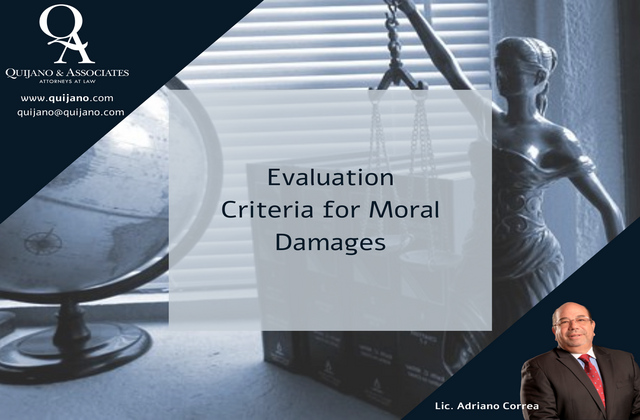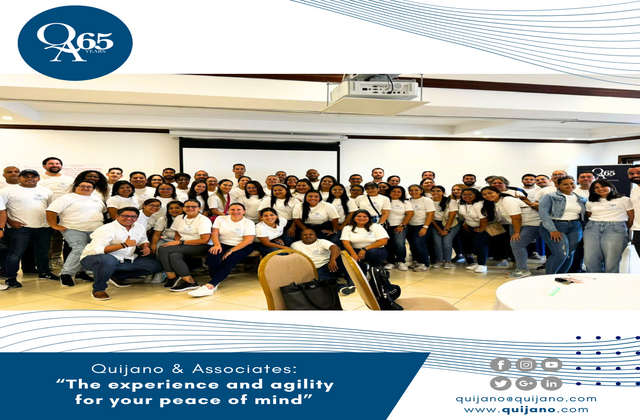Evaluation criteria for Moral Damages

Introduction:
The subject of moral damages is perhaps one of the most challenging to deal with, and even more difficult is trying to develop some criteria for how it should be evaluated. This article is intended to show that the determination of moral damages is an objective task. Our judges and magistrates daily face the commendable and controversial work of calculating a “monetary compensation” for a damage that the doctrine qualifies as non-pecuniary, meaning that it is not subject to economic valuation. What equally motivates us is to try to establish some basic criteria in accordance with the Standards of Psychiatry and Psychology by framing it in within these sciences. How do we calculate the amount that we have to compensate when feelings, affections, beliefs, decorum, honor, reputation, etc. are affected?
I. Concept and Definition of Moral Damages:
Moral damage refers to the way a person suffers in his feelings, affections, beliefs, decorum, honor, reputation and privacy. Before knowing how these damages can be valued, we need to specify what they are.
II. Psychology of Affectivity:
1. Situation Feelings:
These are feelings referring only to the ego state. They are classified as pleasant (happiness, pleasure, agility, joy, rest, satisfaction, security); and unpleasant (sadness, worry, anguish, fear, restlessness, uneasiness, failure, helplessness, nostalgia, bad mood, anger, rage, envy, jealousy, etc.).
2. Feelings of Self-Worth and Exo-Valuation:
The feelings of self-worth are those that refer, as the code says, to the consideration the person has about himself. These can be affirmative such as strength, pride, vanity, dignity, superiority, triumph, comfort, or they can be negative such as shame, guilt, etc.
The feelings of exo-valuation are those that concern the consideration that third parties have about a person and are also classified in affirmatives such as love, trust, compassion, interest, justice, nobility, and in negatives such as hate, repugnance, contempt, indignation, etc.
III. The Determination of Moral Damage:
It must be proven that the unlawful action has produced a moral damage and, in addition, that it is only indemnified when the damage caused is compensated financially. In our humble opinion, moral damage can only occur when there is damage of a psychological nature that affects any of the feelings we have already described.
IV. Criteria for Determining Moral Damages:
As mentioned above, our judges must set a monetary compensation for a situation that the same doctrine calls non-pecuniary damage.
We must undertake this task first remembering that, since feelings are the subject of a universal number of stimuli, there will be as many moral damages as situations that cause them.
We will then discuss the moral damages that are most commonly requested, in order to outline evaluation criteria.
The standard offered in article 1644 of the Argentine Civil Code clearly establishes that the amount of the moral damages will be determined by the judge, taking into account the following factors:
1. The rights of the injured parties;
2. The degree of responsibility;
3. The economic situation of the person in charge;
4. The economic situation of the victim; and
5. The other circumstances of the case.
Let us remember that we are referring to the problem of pecuniary compensation for moral damages and not to the compensation of the integrity of the aggrieved individual to whom the same Article 1644 establishes the way in which this reparation should take place.
Let us examine each of the parameters with which the judge must restore a pecuniary value to the moral damage.
1. Right of the Injured:
Specifically, it is limited to the moral damage of an injured person, and within this specific situation, it is appropriate that we frame ourselves in the responsibility derived from the offense of negligent injuries regulated in Article 139 of the Criminal Code, whose maximum representation in our law is the processes of culpable injuries or for recklessness.
Does it mean that in the crimes of culpable homicide there is no room for a request for moral damages? In our opinion, applying the analogy, since we are under the aegis of the civil law that allows us to use it, and since the effect on emotions and feelings is due to different stimuli, we would conclude that it is possible, even though the law does not establish it directly. We maintain that the way the article is written is an example and not restrictive, which has been reflected in the law as examples of the criteria that the judge must follow in order to determine the quantum of moral damages. These may also include the rights of those affected by the death of a father, son, brother, etc.
In analyzing the criteria of the moral damages caused by the death of a parent, it might be suggested that the criteria be to assess moral damages at twice the amount of the compensation proven in the material part. That is, to provide the family with the resources that the parent would have provided, within the economic possibilities that the family had at the time of death.
Since most people would not change their lives for money, we cannot think that the moral indemnity is infinite, even if that indemnity does not “repair” in the strict sense of the word, since the deceased could never be resurrected.
The limitation comes if the deceased does not have employment at the time of death. With such high unemployment rates, it is not uncommon for some people who have died in car accidents to report no income at all, and this does not mean that their life is worthless, it is as much as if the assumption was that the person had died “with no use in living.”
If we are dealing with the death of a minor child, the situation is much more complicated, however author Richard A. Posner suggests that the pecuniary compensation would be the cost of maintenance based on the opportunity costs of the market. If we take this as a basis for compensating this difficult transaction for moral damages, we suggest at least three times the pecuniary compensation.
2. The Degree of Responsibility:
This criteria assumes the co-authorship and participation in the loss or impairment of the life or physical integrity of the person, a situation that the judge must take into account in order to impose moral damages in this case. It would then be that the co-perpetrator or accomplice, depending on his degree of responsibility, could be sentenced to pay greater or lesser compensation.
3. Financial Situation of the Responsible Party:
Of the criteria, this seems to us to be the most objective of all. However, this situation is not like that of the person obliged to give child support, in which the child support provider is considered largely by his economic situation. The extent of the impact on one’s emotional life, in our opinion, has nothing to do with the economic means of the defendant. However, because there is no means of compelling the insolvent party to pay in civil proceedings, it is perhaps an appropriate practical criterion. It is useless to establish a sum of one million dollars for moral damages to someone who cannot pay that amount, however nothing prevents you from using the criteria above to reach that amount of money.
4. Other Circumstances of the Case:
This criteria allows the judge to take into account other circumstances when evaluating the evidence of the specific case.
Conclusions:
- Given that the object to be valued of the moral damages are the feelings, and these are very personal by definition, the valuation of the moral damages must be done in a subjective way using objective criteria relative to the victim’s circumstance.
2. Feelings are susceptible to being located according to Schneider’s classification, and can and should also be tested, although on some occasions the physical and biological damage results in moral damage which is always of a psychological nature.
3. The criterion of US$ 3,000 could be exceeded if the judge uses some of the criteria herein for a fairer assessment of moral damages without this causing the victim who suffers the damage to receive exorbitant compensation, always taking into consideration the economic reality of the victim.
4. Human life has no economic value per se; however, the suppression of life causes effects of a patrimonial nature. What is attempted to be measured economically is not life, but the consequences that the interruption of life has on the victim’s patrimony, and the opportunity cost that the victim had, which can be evaluated at a given time.
5. The unhappy wording of Article 1644a of the Panamanian Civil Code outlines somewhat poor and sometimes implausible criteria for the valuation of moral damages.
6. The compensation for moral damages seeks to redress or compensate for psychological situations, since at the time of payment the difficult situation has already passed.
BIBLIOGRAPHY
DEVIS ECHANDÍA, Hernsndo. Teoría General de la Prueba Judicial, Tomo I, Editorial Biblioteca Jurídica Dike, Medellín, 1993.
GHERSI, Carlos A., Accidentes de Transito, Derecho y Reparación de Daños, Editorial Universidad, 1995. OSORIO, Manuel. Diccionario de Ciencia Jurldicas Políticas y Sociales, editorial Heliasta. Buenos Aires, 1994.
SANTOS BRIZ, Jaime. Derechos de daños, editorial Revista de Derecho Privado, Madrid, 1982.
TAMA YO JARAMILLO; Javier. La Culpa Contractual, editorial Temis. Bogotá 1990.
VALLEJO NÁGERA, A. Tratado de Psiquiatría, Editorial Salvat, V edición, Madrid, 1968.
VEN/NI, Juan C., Responsabilidad por Deñoe y Contractual y Extracotractual, Editorial Juris, Santa Fé, Rosario,
1990
WYRSCH, J. Psiquiatría Forense, editorial Epasa Ca/pe. Madrid, 1949.




